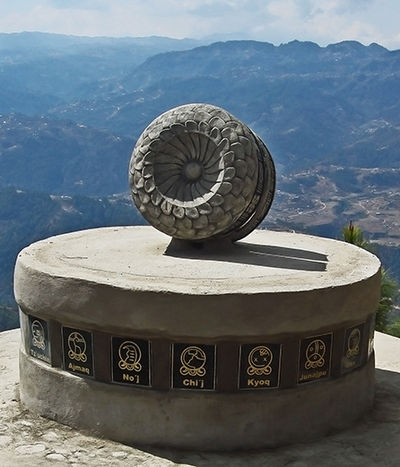Maya Hackers WikiLab
Contents
Overview
Introduction
Maya Hackers is a bundle of projects at the interphase between art, culture and social design. The projects concentrate in Mayan culture and explore the ways in which ancient cultural elements can be "Re-injected" into Guatemalan culture, as part of the transformation process taking place in the country.
The name comes from the article: Maya Hackers and the Cyberspatialized Nation State, by American sociologist Diane Nelson, where she notes that the transformation of the country stirred up by indigenous organisations proceeds by Re programming the collective imagery, to change the imposed view that the indigenous culture is backward, obsolete, useless, and incompatible with science and technology.
The Maya Hackers projects propose future oriented views of Mayan culture at the interphase with other cultures, to break off with the strong stereotype that indigenous cultures are something from the past. In the same way the evolution of our body is stored in our DNA, many ancient cultural memes remain alive in contemporary culture. If those cultural memes have survived to this day, is because they play a role in the integrity and identity of social groups, and understanding them expands our capacity as human beings.
Age of Wonderland
The Maya Hackers project was presented at the 2014 Dutch Design Week as part of the Age of Wonderland event, organised by the dutch institutions HIVOS and Eindhoven based Baltan Labs. This event allowed to look inside several art and design projects and learn techniques and ideas that have been useful in the continuous process of re-design happening within Maya Hackers. This is particularly important for the Mirror of Winal card deck, the Solar Eye calendar sculpture, and the Kakawa project.
The Seed Projects
The Maya Hackers projects try to spread Mayan culture, in analogy with seeds, the projects should contain the means to grow and propagate. To consider this "sustainability" of a project or the viability of a vector for a culture meme, is to couple it somehow to the economy, the fine point in the design is: Where is its source of energy? Who is going to pay for it?. The projects described below are the more developed ones, but you can find many more in the Seed Projects Full List.
The Mirror of Winal
The Oracle of the 20 Day Signs. This pack of cards and instruction booklet based on the Chol Q´ij Mayan Calendar can be used to explore different variations of an idea, triggered by the influences attributed to each day of a 20 day cycle called winal, which means "person". The Chol Q´ij calendar is one of the most important cultural legacies of the Mesoamerican civilisations and it has been in use for more than 3000 years up to now.
The 2012 beta and only version consists of 260 packs. You can order one from Amazon Here The main feature of this version is the inclusion of the Tziber Nawal characters, somehow the "pokemon" version of each one of the 20 nawales of the Chol Q´ij calendar. The inspiration for this design is the Japanese manga, where ancient cultural elements are introduced naturally in the most futuristic scenarios.
Cartamundi Experience
Trough the collaboration with Baltan Labs it was possible to interview with Marco van Haaften, creative services manager from Cartamundi, the biggest card making company in the world. He personally liked the deck and assured that in his big experience with cards this idea was engaging, however Cartamundi produces thousands of different card decks, and they cannot engage in the production of new card sets, unless it goes trough some procedure. We were addressed to a german company specialised in Tarot card decks, but the thing didn´t go further. However, we got important insights into the whole business of making cards. In particular, that the biggest market for cards is South Corea, and that the many big companies are too busy to study the case. It was also interesting to receive a full catalogue of tarot cards from Cartamundi in order to know everything there is to know about the subject of card design.
As a result, the new version of the Mirror of Winal will use this information to adapt to the South Corean market, and to look for a small company that is able to sense the niche markets that may exist where there is demand of new card sets. To this end we requested the collaboration of Eindhoven based South Corean designer Mingsung Wang from Studio Mashed to discuss the re-design of the cards.
Age of Wonder 100 years of NatLab
Another major contribution of this experience was to meet the british psychiatrist Iain McGillchrist author of the book The Master and His Emisary, on the divided brain and the making of the western world, at the Age of Wonder conference, where several important authors lectured about their views on the future of technology and humanity. This book has many implications for the theme of oracles, randomness and the origin of consciousness, and the new instruction booklet for the cards will be designed with this book in mind. It is very encouraging that McGillchrist very generously replied to a letter I sent asking for permission to cite his work on the Mirror of Winal instruction book, and expressed his interest in the development of this project.
New Version and the Divided Brain
The first prototype of the cards in 2012 took more than 5 years to develop going trough several stages. After the 2012 version, many card decks have been introduced to a wide variety of persons to observe their reactions. Considerable experience was developed in reading and interpreting the cards combined with the insights into the divided nature of the brain, in such a way that the instruction booklet will grow into a little book to gather those experiences.
Culture Vulture
Some persons who practise the Mayan spirituality are not happy about the cards, because the nawales are considered holy spirits, and to use them out of context is seen as an abuse. This is one main concern in the design of the new version of the cards. It lies at the heart of the issue: Are you an open source user of the culture?, or a plagiarizing vulture?
Astronomy Related
Astronomy is a very important topic for the Re Programming of the collective imagery in Guatemala, as both mathematical and astronomical achievements are seen as the landmarks of the ancient Maya civilisation. It is not by chance that such knowledge was suppressed and destroyed. The great demand from the Mayan population to know more about these topics is more that simple curiosity for the sky, it is a strong political statement of re claiming a cultural heritage that was destroyed. Today it is quite remarkable the lack of information available to the population on these themes, even the wikipedia lacks substantial information.
Solar Eye
The Solar Eye is a solar calendar sculpture, the plays of light and shadows on the surface mark the solstices and equinoxes. The design is part of a broader project of studying naked eye astronomy to understand the surviving Mayan codices. This is a long term goal of the Mayan School of Political Action, who financed the Solar Eye in the Tzunen mountain in San Marcos, Guatemala.
Solar Eye at the UNESCO International Year of Light Blog
Future Developments
Following the idea of finding suitable vectors for the diffusion of the projects, the solar eye was presented at the San Carlos State University of Guatemala. Placing the sculpture on the largest university campus in the country certainly will place it in the public imagery, and it will allow several opportunities to repeat the teachings encoded on its shape.
Solar Eye and the Age of Wonderland
The new model of the solar eye is designed to mark six important dates: Solstices, Equinoxes, Ascio and Nadir. These last two dates occur only inside the tropics and correspond to the days when the sun is exactly above the head at midday, and exactly below our feet at midnight respectively. Since most countries in the Age of Wonderland project are inside the tropics, the solar eye sculpture and related project of learning naked eye astronomy connected with the local ancient culture can be naturally transplanted to other countries.
Every different country where the solar eye project is implemented will modify and change the shape and iconography, thus collecting different mythologies, stories, calendars and local customs around the tropics. In fact, for the peoples living in the tropics, the days of zenith and nadir passage of the sun were more important than solstices or equinoxes for ritual purposes.
Astronomy in the Mayan Codices
This project aims to create a series of videos about the surviving Mayan codices, with the goal of making this knowledge available to the Mayan population. There is a real need for this educational material, and no institution is working on it, or even interested in the topic.
Another interesting fact is that there are no pages in wikipedia on the subject, other than very elementary descriptions of the codices. One goal of this project is to contribute to the wikipedia with this material.





